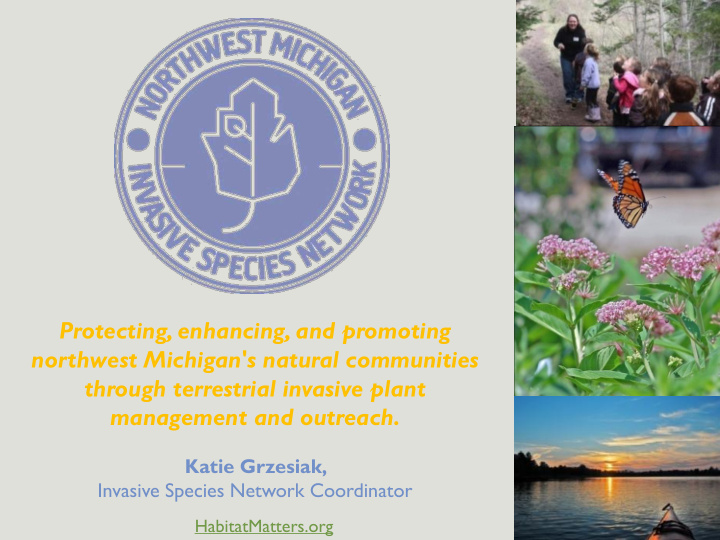



Protecting, enhancing, and promoting northwest Michigan's natural communities through terrestrial invasive plant management and outreach. Katie Grzesiak, Invasive Species Network Coordinator HabitatMatters.org
Major Partners: Funding provided by: Garfield T ownship National Park Service City of Traverse City Grand Traverse Hiking Club Rotary Camps and Services Grand Traverse Audubon Club Grand Traverse County Little Traverse Bay Band of Odawa Indians The Nature Conservancy
Habitat Matters For People For Wildlife For Northwest Michigan
Habitat Matters Michigan Land Cover circa 2006 US Averages: 40% agriculture 55% urban, suburban, and other “disturbed” landscapes 3-5% undisturbed Sources: U.S. Department of Agriculture Doug Tallamy, Bringing Nature Home. Courtesy of Michigan Department of Natural Resources
Mike Davis Mike Davis
Milkweeds Angie Lucas Karen Oberhauser Tim Lindenbaum
Monarchs in Trouble
Nature’s Vast, Unseen World Elms support 213 species of moths and butterflies. Double-toothed prominent ( Nerice bidentata ) on an elm leaf. Bird Food
Nature’s Vast, Unseen World checkered-fringe prominent Schizura ipomoeae Basswood ( Tilia americana ) supports over 150 species of caterpillars Bird Food
Nature’s Vast, Unseen World Carol Groves Pandorus Sphinx Moth, Eumorpha pandorus , on a virginia creeper at Kids Creek Park.
Nature’s Vast, Unseen World Northern spicebush swallowtail (Papilio troilus ) . Hosts: spicebush (Lindera benzoin ), sassafras (Sassafras albidum) . Lisa Brown
Nature’s Vast, Unseen World
Nature’s Vast, Unseen World Woody Plants Ranked by Ability to Support Butterfly/Moth Species Common Name Genus Species Supported oak Quercus 534 willow Salix 456 cherry, plum Prunus 456 birch Betula 413 elm Ulmus 213 pine Pinus 203 chestnut Castanea 125 Source: Tallamy, Doug. Bringing Nature Home. Timber Press, 2007.
Habitat is Beautiful Jim Bruek Carolyn Thayer, Designs in Bloom Landscapes
Habitat is Beautiful Jim Bruek Landscapes
Habitat is Beautiful Landscapes
Habitat is Beautiful Dan Mullen John Beetham Blooms John Beetham
Habitat is Beautiful Mark Brand Jordi Chueca Forms
Habitat is Beautiful T om Potterfield Joshua Mayer Phillip Merritt Greenery
Habitat is Beautiful Superior National Forest Kurt Wagner Wildlife Use
Nature’s Vast, Unseen World Woody Plants Ranked by Ability to Support Butterfly/Moth Species Common Name Genus Species Supported oak Quercus 534 willow Salix 456 cherry, plum Prunus 456 birch Betula 413 elm Ulmus 213 pine Pinus 203 chestnut Castanea 125 Source: Tallamy, Doug. Bringing Nature Home. Timber Press, 2007.
How Long Until “Non - Native” Becomes “Native?” How long does change take? Hosting Capacity of Alien Plants Introduced to North America Plant Species Herbivores Herbivores Years Since Supported in Supported in Introduction to Homeland North America North America Black sally 48 species 1 species 100 Melaleuca tree 409 species 8 species 120 Indian fig cactus 16 species 0 species 250 Invasive 170 5 species 300+ Invasive phragmites species Phragmites Source: Tallamy, Doug. Bringing Nature Home. Timber Press, 2007.
What’s Invasive? Non-native Few natural predators Massive seed production Invasive honeysuckle Jake Hendee Native monarch caterpillar eating native milkweed leaf Agriculture and Agri-Food Canada Archive, Agriculture and Agri-Food Canada, Bugwood.org Purple loosestrife beetle introduced for biocontrol Wolfgang Meinhart Frankenstoen, Bugwood.org
What’s Invasive? Formal definition – a non-native species that harms people, the environment, or the economy. Jörg Hempel Saffron Blaze Michigan Natural Features Inventory Environmental harm – a natural area consisting mostly of one or a combination of introduced plants that provide minimal habitat value.
How Do They Get Here? Imported accidentally Glossy/common Invasive Phragmites buckthorn Imported for John M. Randall, The Nature Conservancy, Bugwood.org gardens Planted to manage soil erosion Mark Lindsay Garlic mustard Autumn olive Imported for food or medicine Grand Traverse Regional Land Conservancy
Invasive ID Guide Top 20 “Least Wanted” Species Developed by ISN Partners in October 2010 Lists plants with greatest impacts Half of the Top 20 plants still sold for landscape use
Reporting Report invasive species sightings to http://www.misin.msu.edu/report
Partnerships — Using Invasives • Autumn Berry Preserves – Invasive autumn olive fruit • Product already being made – ISN labeling – Education vs. Promotion • Control still #1! • Garlic Mustard Paper – Workbee-pulled garlic mustard • 4,000+ lbs wet for 250 lbs dry • = 20,000+ sheets = 40,000+ cards – “Habitat Matters” Holidays 2014
Go Beyond Beauty Go Beyond Beauty — for wildlife habitat, healthy waters, and bountiful gardens. A program to remove invasive species from local nurseries’ and landscapers’ inventory. • Keep ornamental invasives from spreading due to planting • Outreach & education about participants’ efforts to preserve native habitat
“Alternatives” Brochure
Invasive Ornamentals John M. Randall Mark Brand Steven J. Baskauf Shaun Howard, TNC Mark Lindsay Pennsylvania Department of Conservation and Natural Resources Davesgarden.com Ted Bodner Kristian Peters
State-Banned Ornamentals Olivier Pichard Matthew Bertrand John D. Byrd
Early Detection Invasive Ornamentals Gernot Hochmueller Jill Fejszes Jerry Kirkhart Enchanted Gardens Design University of Connecticut, Horticulture Wasyl Bakowsky
Protecting, enhancing, and promoting Northwest Michigan's natural communities through terrestrial invasive plant management and outreach. Questions? Katie Grzesiak (231) 941-0960x29 kgrzesiak@gtcd.org HabitatMatters.org
Recommend
More recommend